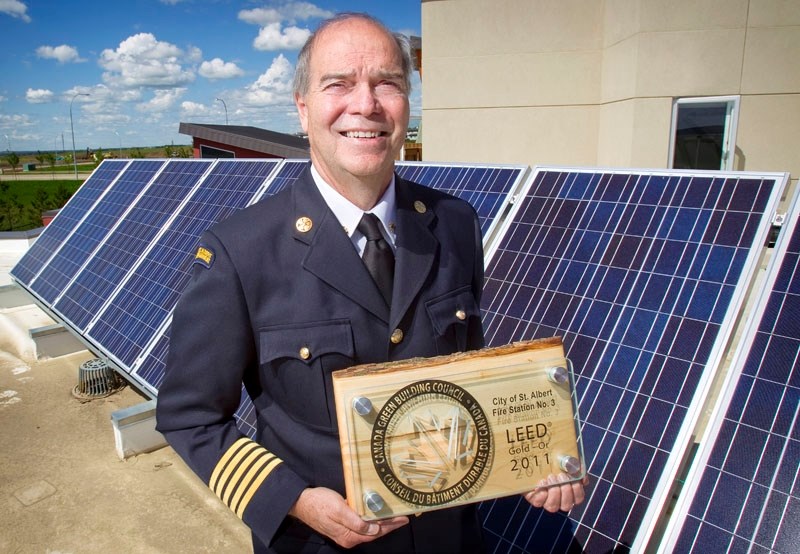St. Albert got its first official LEED Gold building this week, but it could also be its last due to its cost.
The Canada Green Building Council's Alberta branch announced Wednesday at Fire Station No. 3 that the hall had officially achieved the LEED Gold standard. The Leadership in Energy and Environmental Design program is a national standard that promotes environmentally sustainable buildings.
The hall is the first fire hall in Alberta and the second in Canada to reach LEED Gold, said Tanya Doran, spokesperson for the Canada Green Building Council at the ceremony and local resident.
"I'm honoured to say that this is my fire hall," she said.
Just 22 buildings in Alberta have reached LEED Gold, which is the standard's second highest rank.
This building shows the city's commitment to stewardship and safe working environments, said St. Albert Mayor Nolan Crouse.
"While we have challenges in other fire halls and other facilities in our community, the one thing we have done is put our money where our mouth is with regards to Fire Hall No. 3," Crouse said.
Bright and green
Fire Station No. 3 opened in 2009 with many features designed to reduce its environmental footprint, such as solar panels, dual-flush toilets and a mow-free lawn made from native vegetation.
Then-councillor Neil Korotash lead the charge to make the building LEED Gold in 2007, said Guy Boston, the city's manager of planning and engineering, and it was a tough pill to swallow: the economy was red-hot, and going for gold added $645,000 to the hall's price.
The new hall uses about 75 per cent less water and 12 per cent less natural gas than the other ones in town, Boston says, and is made of 15 per cent recycled material. Its solar panel had prevented about 5,400 kilograms of greenhouse gas emissions — equivalent to taking a car off the road for about 200 days.
It's also much easier to work in than Fire Station No. 1, said St. Albert Fire Services chief Ray Richards.
"The only meeting room we had in the old fire station was my old office," he said, adding that now they have several, as well as ample space to train crews and maintain equipment.
The building also provides crews with personal storage lockers, separate male/female washrooms and plenty of natural light. On top of all that, Richard said, they have lower water and energy bills.
"This station brought the department into the 21st century."
Wavering LEEDership?
The city's Environmental Master Plan (EMP) says that St. Albert will reduce its greenhouse gas emissions in part by adopting at least a LEED Silver standard for all new city buildings.
Getting to LEED Gold was difficult and expensive, Boston said, and he was uncertain if the city would try for it again.
"We're going to think long and hard before we say from the get-go that a building will be going after a gold or silver certification," he said.
The city also chose not to renew the building's two-year subscription to wind power, meaning that it is no longer emissions-free when it comes to electricity.
"We've seen some pretty severe escalation in the cost of energy," Boston said, and they could no longer justify the expense.
It'll be up to future councils to decide if it's worth going LEED again, Crouse said.
"My guess is each [LEED-certified building] is going to be a one-off," he said, as the EMP is subject to council approval.
Buildings account for about 35 per cent of Canada's greenhouse gas emissions, said Gordon Howell, the renewable power engineer involved with Fire Station No. 3's solar panels, and they stick around for decades.
We need much more efficient buildings if we want to avoid the worst of climate change, he added.
"The worst thing we can be doing now is to make our buildings lousy from the start," Howell said.




